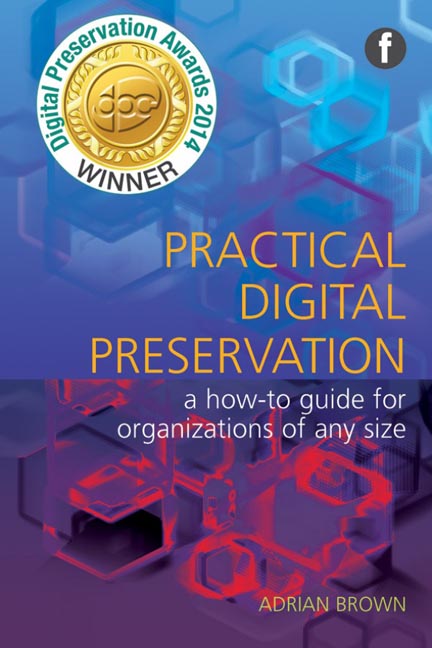Book contents
- Frontmatter
- Contents
- Acknowledgements
- Glossary
- 1 Introduction
- 2 Making the case for digital preservation
- 3 Understanding your requirements
- 4 Models for implementing a digital preservation service
- 5 Selecting and acquiring digital objects
- 6 Accessioning and ingesting digital objects
- 7 Describing digital objects
- 8 Preserving digital objects
- 9 Providing access to users
- 10 Future trends
- Appendices
- Bibliography
- Index
2 - Making the case for digital preservation
Published online by Cambridge University Press: 08 June 2018
- Frontmatter
- Contents
- Acknowledgements
- Glossary
- 1 Introduction
- 2 Making the case for digital preservation
- 3 Understanding your requirements
- 4 Models for implementing a digital preservation service
- 5 Selecting and acquiring digital objects
- 6 Accessioning and ingesting digital objects
- 7 Describing digital objects
- 8 Preserving digital objects
- 9 Providing access to users
- 10 Future trends
- Appendices
- Bibliography
- Index
Summary
Introduction
Building a digital preservation service requires resources, including staff time and skills, budget and technical infrastructure. More fundamentally, it requires an understanding from the organization that digital preservation is a high priority, and a commitment to the principles and practice. Securing such a mandate is therefore critical: with it, you have taken a crucial first step towards delivering a successful service; without, it will be an uphill battle to achieve anything.
This chapter describes the drivers for implementing a digital preservation service, and strategies that you can adopt for making an effective business case to secure senior management buy-in and resources. it advocates the development of a digital preservation policy as a first step in building this case, including a discussion of techniques for quantifying the financial and non-financial benefits of implementing a successful preservation solution, and introduces the concept of a digital asset register. finally, it considers the essential elements of the business case itself.
Building an effective business case may initially seem daunting, but can be broken down into a series of simple steps, as illustrated in Figure 2.1.
This chapter considers each of these stages in detail, illustrated with examples, from understanding the fundamental arguments to use, to developing a comprehensive business case.
Understanding the drivers
A good understanding of the drivers for digital preservation is obviously a prerequisite for developing a compelling business case. Every organization has its own unique imperatives, but there are many generic arguments which should be considered.
Collection development
The growing ubiquity of digital ways of working in our business, cultural and social lives is reflected in the increasing desire by many organizations to acquire digital content. Whether it be the library moving from print to electronic journals, or the gallery displaying new forms of digital art, digital information is becoming a fundamental aspect of collection development.
Corporate memory
Most organizations retain information as part of their ‘corporate memory’, in the form of institutional archives and libraries. Besides the obvious historical purpose, these have a wider role in maintaining the accumulated knowledge and expertise of the institution. This may be especially important if highly specialized knowledge is critical to the organization over long time periods, for example in the fields of aerospace engineering or pharmaceuticals.
- Type
- Chapter
- Information
- Practical Digital PreservationA how-to guide for organizations of any size, pp. 19 - 46Publisher: FacetPrint publication year: 2013



